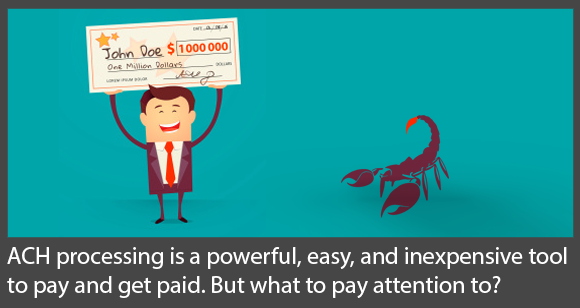4 ACH Processing Mistakes That Can Sting You
ACH processing is a powerful, easy, and inexpensive tool to pay and get paid. Eliminating paper invoicing & mailing costs, improving your cash flow with automated recurring billing, and as a less costly alternative to credit cards.. ACH is a long-time favorite payment tool of many industries.
And if you’re just now considering getting an ACH processing account or you’re already using an ACH service this is a good time to review some critical items that should be on your radar.
Regulatory agencies are scrutinizing the payments industry and that means banks and processors are taking a closer look at their merchants to ensure they’re in compliance. Putting the following on your operations and internal compliance to do list can ensure you’re taking the appropriate measures to operate correctly so you don’t get stung..
Here’s my short list of what to pay attention to:
1) Not using bank account verification – creates risk of losses and high returns
It surprises me how many businesses are still running naked and blind when it comes to accepting these forms of payment and not using any type of verification on the front end before the payment is processed and before goods and services are delivered.
We frequently see this problem occurring when merchants are using their bank or an ACH processing company that don’t offer these types of verification tools coupled with their ACH accounts.
So the effects can be a colossal waste time, effort, money, and resources. Not to mention the potential risk of losing your processing relationship if ACH returns are too high.
2) Lack of proper POA (proof of authorization) and transaction record keeping for later requests
It’s a compliance requirement that you keep authorizations accessible should they be required by your ACH provider. And the type of authorization required will depend on the type of transactions you’re accepting. The ACH jargon is SEC (standard entry class) and there are several transaction class codes. We won’t cover them all here but the most common include:
(TEL) Telephone-Initiated Entry
(WEB) Internet-Initiated Entry
(PPD) Prearranged Payment & Deposit Entry (Business to Consumer)
(CCD) Cash Concentration or Disbursement. (Business to Business)
If you’d like more information on using the proper authorization method for each then give us a call and we’d be happy to help. The take away for you here is that you need to have proper authorizations in place and method for storing and retrieving those authorizations at a later date should these be requested. This is extremely important yet you’d be surprised how often merchants get themselves into trouble by not doing this correctly. As they say, “an ounce of prevention is worth a pound of cure”.
3) Not notifying your customers prior to debiting their account can increase unauthorized returns
Sending email and text notifications to your customer prior to processing a transaction is extremely helpful especially if you’re billing your customers quarterly or annually. When it has been a while since they’ve seen a debit from your company hit their account they’ll commonly forget and call their bank stating the transaction is “unauthorized”. And that’s a big problem for you. This can be easily avoided with giving them advance notice. What’s great about adding the text feature is the deliverability. Just about everyone reads their texts. Emails can get caught in spam traps. So we suggest both notification methods especially when the period between billing cycles is long.
4) Lack of return ratio monitoring can cost you your ACH processing relationship and make it extremely difficult to obtain new processing
Just to get a little industry jargon out of the way…the term ACH chargeback refers to return codes designated by NACHA rules as “unauthorized”. Those unauthorized return codes are (R05, R07, R10, R29). And the threshold for unauthorized debit entries is currently 1.0 percent. That means you can only have 1 chargeback for every 100 transactions you process. Furthermore, NACHA is proposing reducing that threshold to 0.5 percent. So what does this mean?
You need to take the monitoring of your transaction activity very seriously and make sure whomever you choose to work with can provide access to reporting so you can self-monitor your ratios. You don’t want to find out when you’re already over threshold. I also tell merchants, “you don’t have a charge back problem you have a customer service and marketing problem”. (see my article on techniques to reduce ACH chargebacks). Charge backs are a symptom lurking in one’s business. The key is to find out what’s causing it. As a doctor would say.. don’t treat the symptom treat the cause.
The take away here is take ownership of your monitoring because if you lose your account it’ll be next to impossible to obtain future processing. It’s almost akin to going bankrupt in that your record follows you around wherever you go in the form of your previous processing history.
If you have questions on the information shared in this article, or need assistance with a processing solution, give us a call or send us an email and let’s chat about your specific needs. I encourage you to share your comments. If you found this useful please share with a friend.







